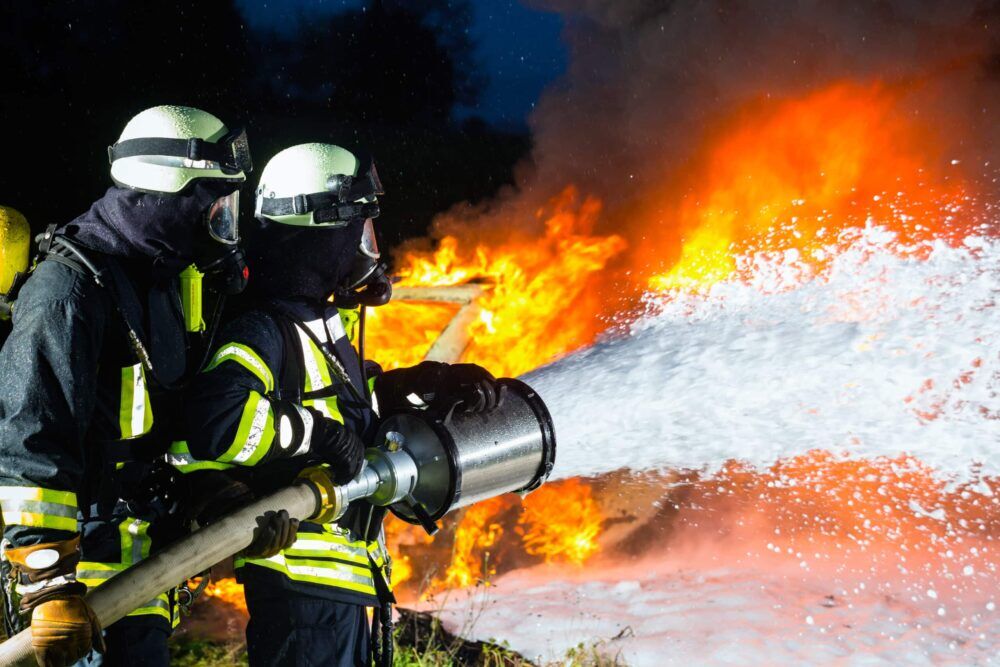
Firefighters, military personnel, chemical plant workers, and others exposed to Aqueous Film Forming Foam (AFFF) may be at risk of developing severe health problems including multiple types of cancers. The risk is linked to exposure to Per- and Polyfluoroalkyl (PFAS) chemicals, also known as forever chemicals, as they do not break down. PFAS chemicals remain in human blood and the environment indefinitely.
AFFF lawsuits aim to help victims of serious health conditions related to firefighting foam exposure recoup financial losses, and hold the manufacturers of these dangerous substances accountable for their actions.
If you or a loved one was exposed to AFFF and subsequently developed cancer, you may be eligible to receive compensation. Contact the attorneys at the Joye Law Firm today for a no-obligation consultation, and find out if you qualify for a firefighting foam lawsuit.
What is Aqueous Film Forming Foam (AFFF)?
Aqueous Film Forming Foams (AFFF) are Class B firefighting foams used to suppress flammable liquid fires, such as those involving fuels, oils, and other hydrocarbons. These foams have been used by fire departments, military operations, and many other industries since their invention by the Navy and 3M in 1966. They were developed after a fire on the USS Forrestal killed 134 sailors. These foams are designed to create a thin, protective film on the surface of the flammable liquid, preventing the release of flammable vapors, thus suppressing the fire. AFFF contains a mixture of water, fluorochemical surfactants, and foam stabilizers. It is commonly used in various fire suppression systems and by firefighters to combat fires involving flammable liquids.
AFFF is used in the U.S. military, and most civilian applications worldwide, as either a 3% or a 6% concentrate. The numbers refer to the percentage of the foam concentrate mixed with either fresh or seawater. AFFF is highly toxic, as it contains between 50% and 98% PFAS, a group of over 9,000 toxic chemicals. Both concentrations carry extreme risks for those exposed.
While AFFF has been effective in fighting certain types of fires, it is important to be aware of potential health and environmental risks associated with its use.
Environmental Risks:
- Groundwater Contamination: AFFF contains per- and polyfluoroalkyl substances (PFAS), which are persistent and can leach into the ground, potentially contaminating groundwater. PFAS have been linked to various health and environmental problems.
- Surface Water Contamination: AFFF runoff can enter surface water bodies, leading to the contamination of rivers, lakes, and other aquatic environments. This can harm aquatic life and ecosystems.
- Bioaccumulation: PFAS compounds can accumulate in the food chain, potentially leading to increased exposure for animals and humans who consume contaminated fish or other organisms.
Health Risks:
- Exposure to PFAS: Prolonged exposure to PFAS through AFFF or contaminated water sources may lead to adverse health effects, including potential risks to the liver, immune system, and other health concerns.
- Occupational Exposure: Firefighters and emergency responders who use AFFF are at risk of inhaling or coming into contact with PFAS, potentially leading to health issues. This has raised concerns about occupational health.
- Long-Term Health Effects: The long-term health effects of exposure to AFFF-related PFAS are still an active area of research, but there is growing concern about potential associations with various health conditions including multiple types of cancers.
It’s worth noting that there are ongoing research and regulatory efforts to address the environmental and health risks associated with AFFF and PFAS compounds. Some regulatory bodies have taken measures to restrict or phase out certain types of AFFF formulations to mitigate these risks.
